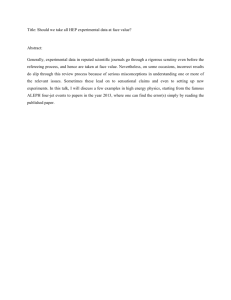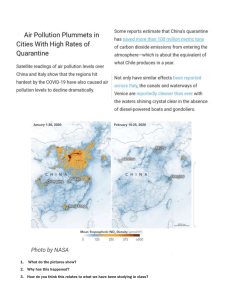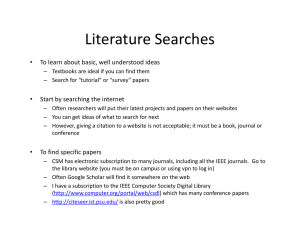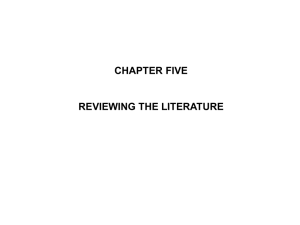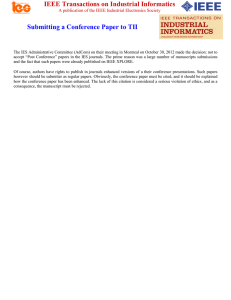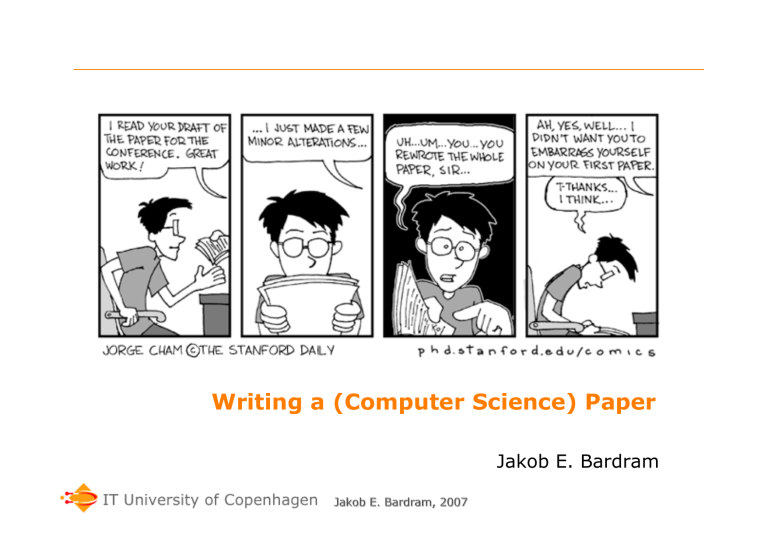
Writing a (Computer Science) Paper Jakob E. Bardram Today • • • • Why write a paper? When to write a paper? Types of papers How to write a paper? – how to write an abstract? • • • • Where to send it? Co-authorship Refereeing Some practical advice 2 Why write a paper? • Science is all about reporting on research – A contribution only exists if and only if it is documented • Eating the elephant in smaller pieces – focus on a specific contribution – rather than telling the whole story • The main component in your CV – and hence for your future (academic) career • The main source for your peers to get to know you – the best way to be famous is form your work • Work as a way into internships, etc. • In Denmark – may be the parts making up your thesis 3 When to write a paper • When you have something important to share with others – a new idea – new data – an intelligent review of existing work • Mature results – research milestone completed – can articulate the results • clear problem statement, solution, and contribution 4 5 Types of papers I • Review paper – a survey of a specific area, technology, methods, etc. – you need to do this anyway – can be published • Analysis paper – workplace study – theoretical analysis – technical analysis, comparison, or review • Design paper – – – – a new technical design user interface techniques / UI design / Interaction Design software architecture ... 6 A Review Paper J. Hightower & G. Borriello. Location Systems for Ubiquitous Computing. 7 IEEE Computer, Aug. 2001 Types of papers II • Systems paper – describe a system / piece of technology – Proff-of-Concept • Theoretical paper – Proves some properties ... • Evaluation paper – Technical evaluation – Usability evaluation – Pilot study • Methods paper – a new method / methodology for ... – new process • Position Paper – a statement / critical message – normally not considered a contribution 8 How to write a paper? • • • • • • • • • • Find the contribution Outline Related Work Identify and engage co-authors Identify the readers / target outlet Ensure validity Ensure quality Write good English Proofread Submit Revise 9 A Scientific Contribution I • Adds to “knowledge” – thus it must be a written contribution – and not only something you did – what can others learn from this • Typically addresses a clear stated problem – and explains well, what is new – the „delta“ to existing work • Relevance of a scientific contribution - some metrics – relates to the relevance of the problem – relates to the #citations – relates to the publication • the kind (workshop, conference, journal) • the ranking of the conference/journal 10 Learn the “Game” • What is the “standard” paper in our area? • HCI – needs a user involved somehow – design & evaluation • Workplace studies – needs a non-trivial field study • Systems papers – needs an implementation and some evaluation – good: used by others – better: used by others to build something • Theoretical papers – a proof of something 11 The “Introduction” • Background – Motivation – a real issue? – What is the research context? – What is the state-of-art? • Hypothesis / Problem – What is broken/missing (the ”gab”) – Thesis or Problem statement • Goals and methods – What are the operational goals of this paper? – And how were they achieved? • Results – Contributions • Paper overview – Outline of the rest of the paper Source: Saul Greenberg’s homepage. 12 Main body + Conclusions • Main body – Section organization reflects how your argument unfolds – Each section should have a main point – Each paragraph should have a main point • Summary/Conclusions – Tell them what you’ve told them • some people only read abstract, intro and conclusions – Relate back to general area – Introduce future work 13 How to make the “Abstract” • 1st model ~ systems kind of papers – – – – – Background However, gab What we did ~ innovation Contributions What it means • 2nd model ~ study/medical kind of papers – – – – Background & Purpose Methods Results Conclusions 14 Background & Gab What we did ~ Innovation Contributions Method Results 15 Try 16 Exercise Try to write an abstract for a paper describing the invention of the paper clip 17 Where to Publish? • Workshops – – – – Good for practice Good for networking Not archival, Limited peer-review • Conferences – – – – BEWARE! Quality varies a lot ACM, IEEE Conferences (Springer) Archival Peer-reviewed • Journals – Look for top-rated journals (ACM, IEEE, Elsevier, ...) – Publish in the green-listed journals (Danish) • National publication ... 18 Co-authorship 19 Co-authorship – Simple Rules • All authors should have contributed – to the research – to the paper • Always try to put your professors name on – forces him/her to work with you – if “only” advising, put the name last • Make sure to invite everybody who at some point made a contribution – initial ideas – coding – evaluation 20 Refereeing 21 Refereeing • Just overhead? – your professor hand you all his papers… • Refereeing is excellent practice for – developing critical appraisal skills – understanding how good (and bad) papers are written • Fairness – all your papers will be refereed – expected duty of all researchers/academics • Other upsides – – – – enhance reputation expedites processing of your own papers get on editorial board or program committee 'previews' to the state of the art Source: Saul Greenberg’s presentation on refereeing, “HowToReferee.ppt” from his homepage. 22 A Template for Reviewing • Meta information – paper title, author (if not ann.), manuscript id, … • The review – brief summary (2-3 lines) – “If you can’t, there is probably something wrong with the paper” – Contribution [ACM CHI FAQ] • what is new? is it significant? (novelty/contribution) • would it stimulate further work? (impact) • how relevant is it to the community? (relevance) – Quality of the research • • • • • how sound is the work? how appropriate/reliable are the methods used? how reasonable are the interpretations? how does it relate to existing work? can an experienced practitioner in the field duplicate the results? – Quality of the writing • outline, language, spelling, grammar, figures, … – Recommend acceptance / rejection 24 Receiving reviews 25 Practical Advice 26 Some final practical advice • Copycat – find a very good* paper and literally copy it word by word, sentence by sentence, section by section – *: good in terms of writing – not contribution • Learn from others – write together with others – e.g. your supervisor – read and review other’s papers • Learn to write English – take classes – spend time on writing – it is time consuming – build your (scientific) vocabulary • pick up phrases and words from others • (Try to spilt a paper in two)* 27 Resources • Saul Greenberg’s homepage – http://pages.cpsc.ucalgary.ca/~saul • "So long, and thanks for the Ph.D.!“ – a.k.a "Everything I wanted to know about C.S. graduate school at the beginning but didn't learn until later." – Ronald T. Azuma, UNC, 1997, 2003 • http://www.phdcomics.com/ • ... and a lot of other resources! 28 29
